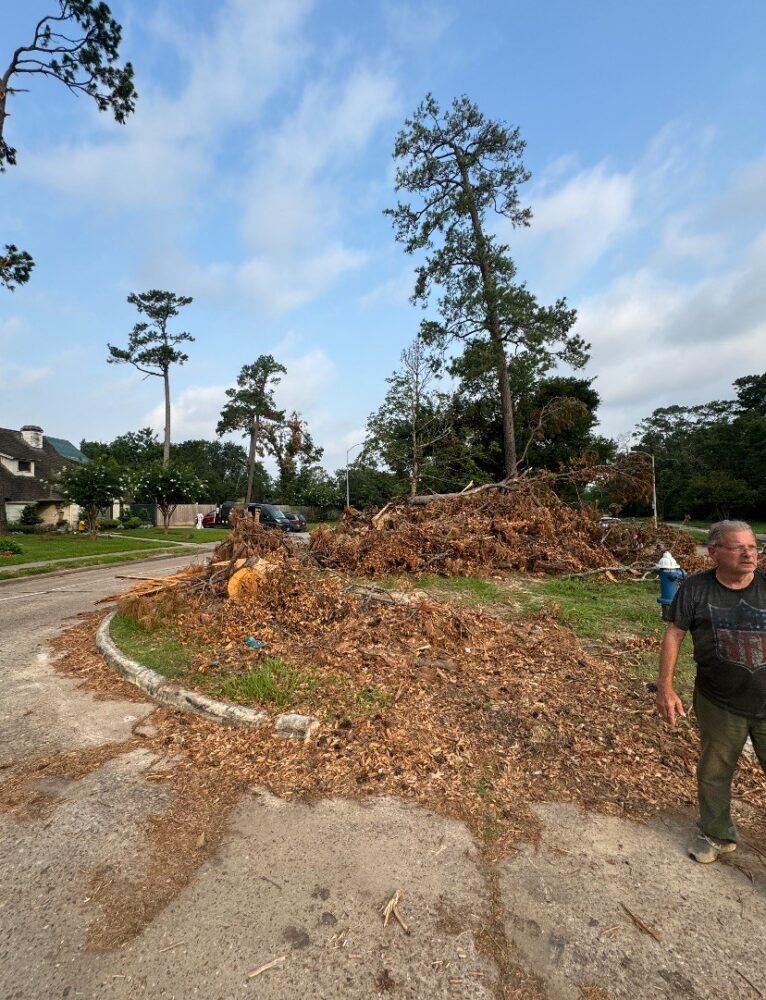Chevonne Greaser lives near a city park and said she and her neighbors are accustomed to seeing snakes and other wildlife near their homes. Lately, though, she said critters have been showing up in front yards and driveways in her part of Timbergrove Manor in northwest Houston.
Greaser attributes their increased presence to the large piles of downed trees, limbs and other debris that have sat on neighborhood curbs for the better part of three weeks. Timbergrove, which as its name suggests is dotted with towering, mature trees, was particularly impacted by the deadly May 16 derecho that produced two tornadoes, caused eight deaths and damaged buildings, infrastructure and trees across the region.
Every other home in her cul-de-sac was struck by a downed tree, according to Greaser, who said Tuesday that each of those houses is still accompanied by a debris pile standing at least 7 feet. They had yet to be picked up by Houston’s Solid Waste Management Department, which began its citywide collection efforts in the days following the storm.
“None of the kids, we don’t let them out front anymore to play in the cul-de-sac. It’s just too dangerous,” said Greaser, a mother of four. “There are big limbs hanging out.”
The Solid Waste Management Department announced Friday it is expected to take up to three months to collect the approximately 1.5 billion cubic yards of residential debris created by the storm – enough to halfway fill NRG Stadium, the home of the Houston Texans football team and annual Houston Livestock Show and Rodeo. The department and its team of contractors had picked up more than 380,000 cubic yards of debris as of Friday, it said.
“They have started the debris cleanup in our neighborhood, and we feel really grateful about that,” Elliott said.
Seeing signs of progress, even small progress, might be the best way to keep impacted residents patient and encouraged as cleanup efforts drag on, Elliott said.
The city’s Solid Waste Management District announced last Friday that it had launched an online tool to track the progress of storm debris collection, with the ability for residents to input their address and see when their debris is scheduled to be collected. The tracker also will include a map displaying areas where debris has already been collected, where it is currently being collected and where pickups are scheduled for the following two days, the department said.
As of Tuesday, though, the website provided in a news release by the city had yet to become functional. A spokesperson for the Solid Waste Management Department did not immediately comment Tuesday when asked about the status of the online tracker.
“They need to get that tracker done,” Elliott said.
Greaser said she also understands the “undertaking is huge” but called it “asinine” that city cleanup efforts could take up to 90 days. She said she hopes the solid waste department can come up with a way to expedite its efforts.
Limited roadway visibility caused by debris piles appears to have contributed to a recent vehicle crash in the Timbergrove neighborhood, according to Greaser, who said there’s been at least one instance in which a resident hired a company to remove a pile from their property and the debris was then placed in the median of a major nearby thoroughfare.
“I don’t know what people are going to start doing in 90 days,” she said.












